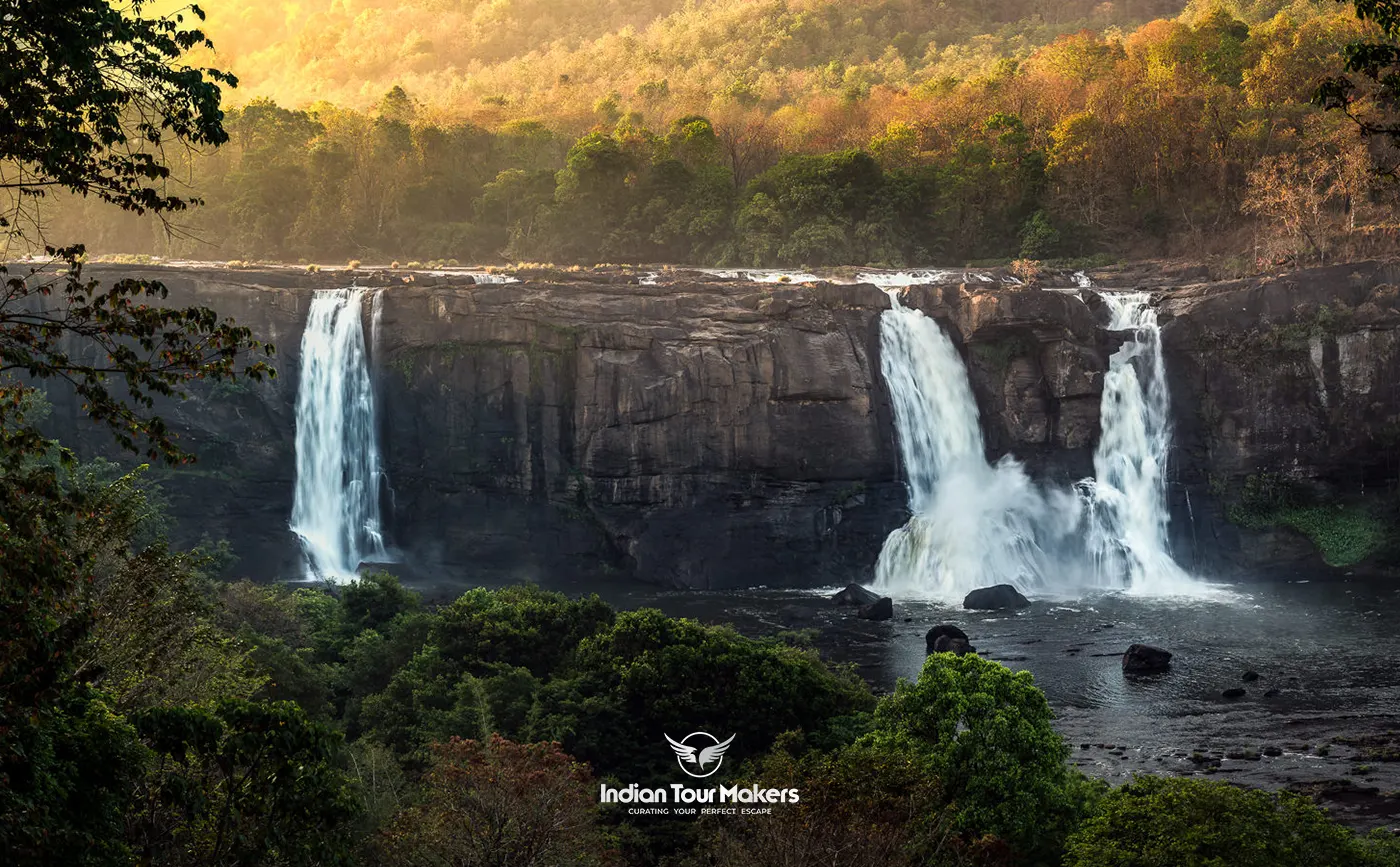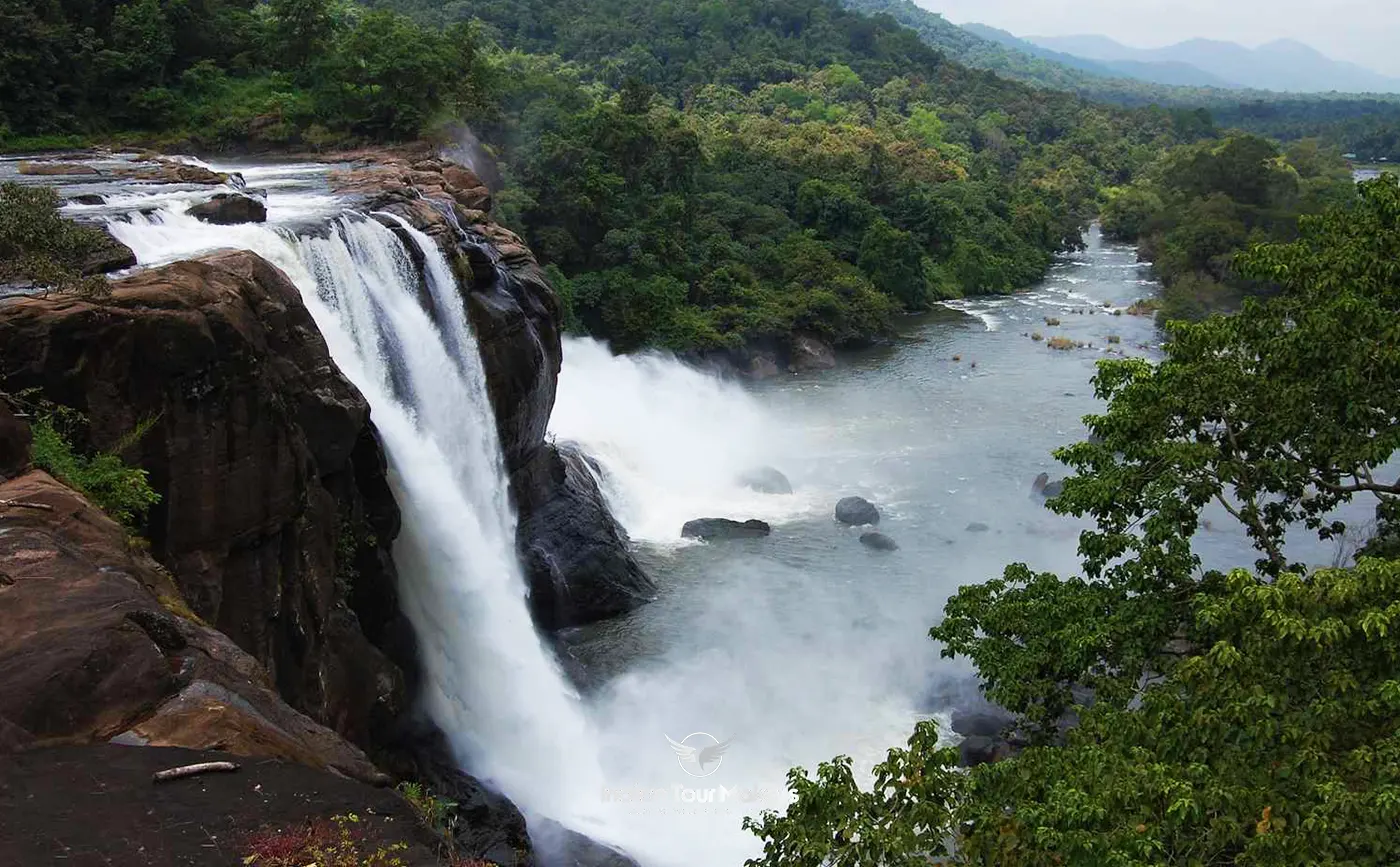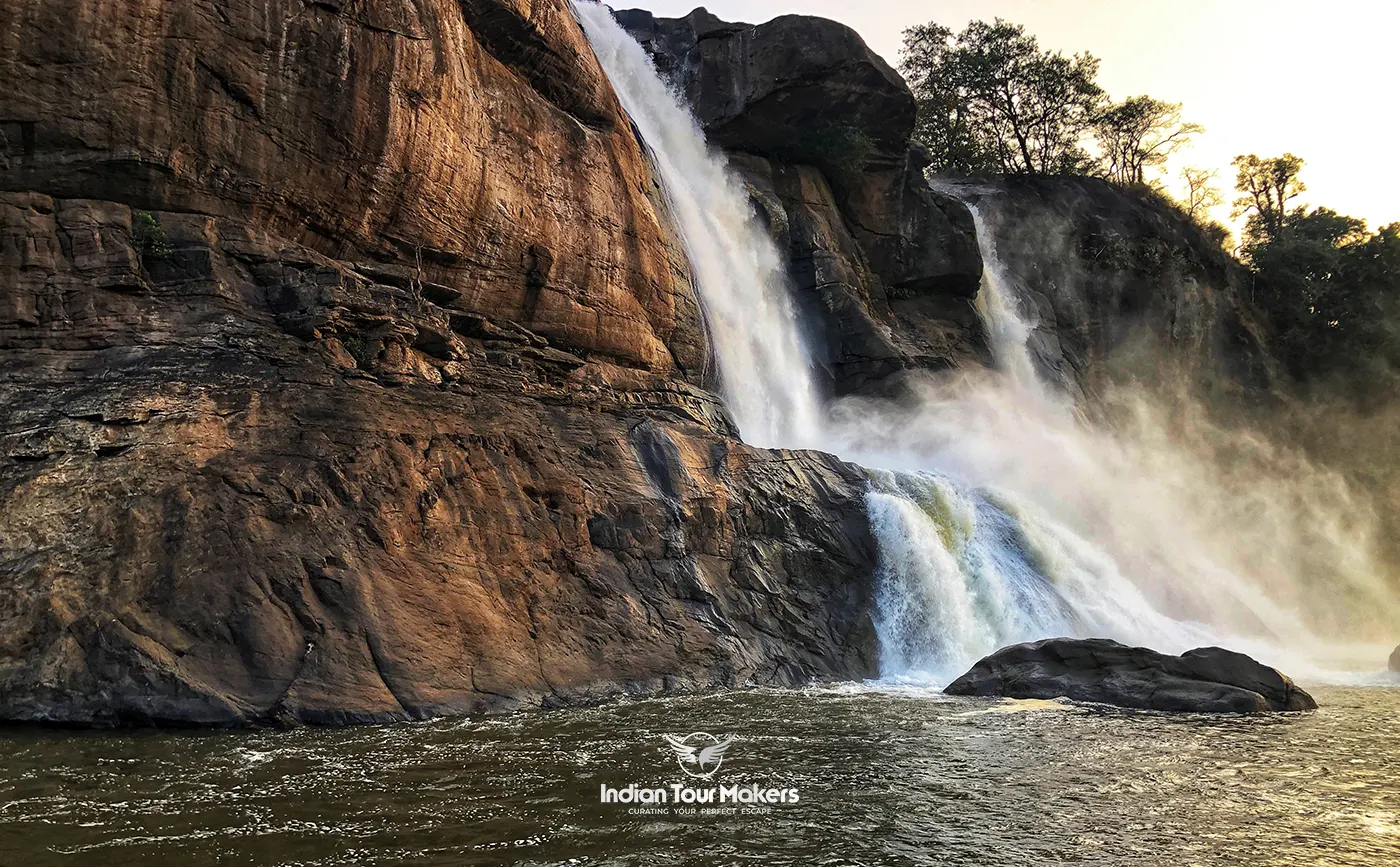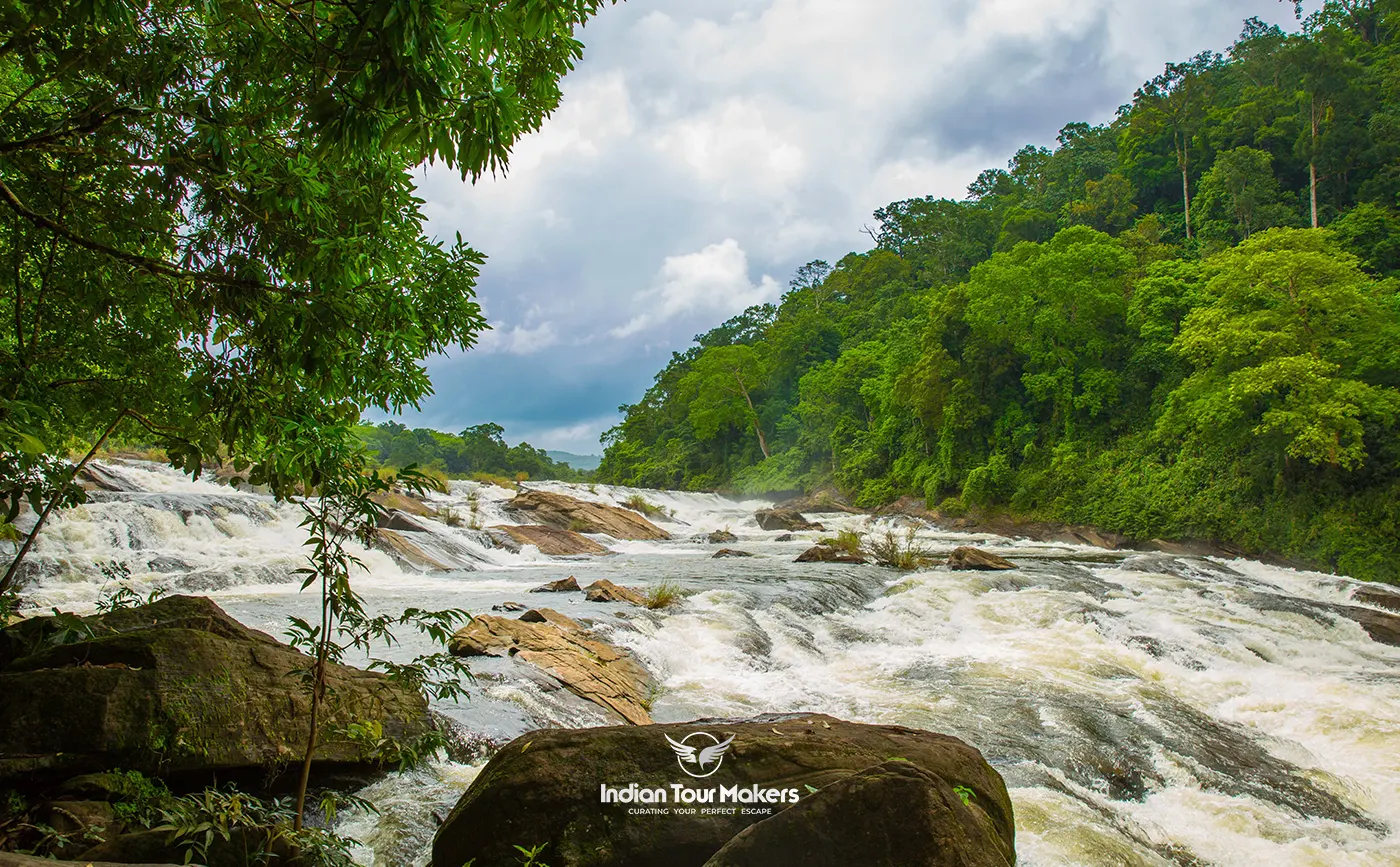





Immerse yourself in the emerald heart of Kerala – Athirapally. Imagine standing at the base of a mighty waterfall. The air cool, the thunderous roar of water plummeting 80 feet onto the rocks echoing in your ears. Look up, squint through the delicate mist, and behold the cascading majesty of Athirapally Waterfalls.
Feel the vibration beneath your feet as the water crushes into the Chalakudy River. A moment to admire nature’s raw power and serene beauty in perfect harmony. Breathe in deeply; it’s the fresh, untouched scent of the rainforest mingling with moistened earth.
Listen. It’s not just the waterfall. It’s the orchestra of the wild. Tropical birds chirping, leaves rustling gently in the breeze, monkeys chattering high above in trees. It’s nature, alive, breathing, thriving.
Walk through the lush green forests, home to a multitude of flora and fauna. Each step unveiling a new sight, a new sound, a new wonder. A paradise for nature enthusiasts, wildlife lovers, photographers, and adventurers.
Beyond the waterfall, explore the tribes, their simple yet fascinating lifestyles, their traditions, and their art. A chance to taste authentic tribal food, a flavorful burst of spices and textures.
Feel the harmony of the natural and cultural worlds converging in the heart of Kerala. This is Athirapally – where each moment feels like a discovery, each sight feels like a treasure. It’s not just a place, it’s an experience. Come, immerse yourself.
Athirapally, tucked away in the verdant landscapes of the Thrissur district, is a testament to Kerala’s rich historical and ecological heritage.
Ancient Beginnings: The region was once under the rule of the Perumals, ancient Tamil kings who reigned from the 5th to the 9th centuries AD. The area later came under the control of the Kochi kingdom, contributing to its cultural and historical tapestry.
Tribal Roots: Athirapally has been the ancestral home to the Kadampuzha and Malayarayan tribal communities. Living in the dense forests for centuries, these tribes have preserved their unique cultural identity and traditions, offering a glimpse into the ancient history of human life in the area.
Colonial Influence: During the British Raj in the late 19th and early 20th centuries, Athirapally and its surroundings witnessed the rise of plantations that led to significant changes in the landscape and the lifestyle of the people.
Eco-Crusader: Athirapally shot to prominence in the 21st century when it became the center of ecological movements. The proposed Athirapally Hydropower Project was met with fierce resistance from environmental activists and the local tribal population, leading to a landmark struggle for the preservation of the region’s biodiversity.
Today, Athirapally is a beacon of natural beauty, tribal heritage, and ecological conservation, attracting visitors from around the world who come to admire its grand waterfall, lush rainforests, and the vibrant history it proudly preserves.
Location: Located in the Thrissur District in the south Indian state of Kerala.
Languages Spoken: Malayalam is the native language, though English and Hindi are also widely understood and spoken.
Climate: Tropical climate, with average temperatures ranging from 20°C to 35°C. Monsoon season (June to November) brings heavy rainfall, enhancing the beauty of the waterfall and the greenery of the forest.
Best Known For: The majestic Athirapally Waterfalls, often dubbed as the “Niagara of India.”
Popular Festivals: Vishu (Kerala New Year), Onam (Harvest Festival), and the Thrissur Pooram, one of Kerala’s most vibrant and grand temple festivals.
Tourist Attractions: Athirapally Waterfalls, Vazhachal Falls, Charpa Falls, Thumboormuzhi Dam & Butterfly Garden, and the lush Sholayar Ranges.
Local Cuisine: Primarily traditional Kerala cuisine, with Sadya (vegetarian meal served on a banana leaf), Appam (pancake made of fermented rice and coconut milk) with Stew, and Karimeen Pollichathu (Pearl Spot Fish) as highlights. The region also has a rich tribal cuisine, featuring dishes like Bamboo Rice Payasam.
September to January: Post-monsoon and winter are ideal times to visit Athirapally. The waterfall is at its full might after the rains, and the weather is pleasant and cool. The surroundings are lush, creating a captivating landscape.
February to May: The summer months are also a good time to visit. Although the heat may rise, early mornings and late evenings are comfortable. The waterfall, though less voluminous, is still a splendid sight to behold.
While Athirapally has a charm that can be appreciated year-round, visitors should note that the monsoon season (June to August) may pose challenges due to heavy rainfall, making some routes impassable. However, the monsoon brings an ethereal beauty to the waterfall and the forest, making it a magical, albeit wet, experience for those who dare.
By Air: The nearest airport is the Cochin International Airport, which is approximately 40 km away from Athirapally. Regular flights connect Cochin with major cities in India and abroad. Taxis or buses can be taken from the airport to reach Athirapally.
By Train: The closest railway station is the Chalakudy Railway Station, about 30 km away. Trains from various parts of Kerala and other states halt at Chalakudy. From the station, one can hire a taxi or take a bus to reach Athirapally.
By Road: Athirapally is well connected by roads. The Kerala State Road Transport Corporation (KSRTC) and private operators run regular buses from Thrissur, Kochi, and other nearby cities to Athirapally. Alternatively, you can drive or hire a taxi from any major city in Kerala.
From Kochi, Athirapally is about 70 km away and from Thrissur, it’s around 60 km away. The scenic drive through the lush countryside is an added bonus of traveling by road.

Subscribe to see secret deals prices drop the moment you sign up!

